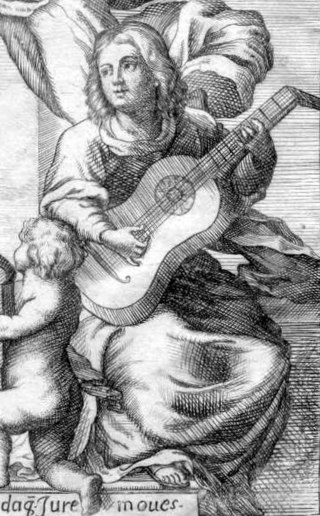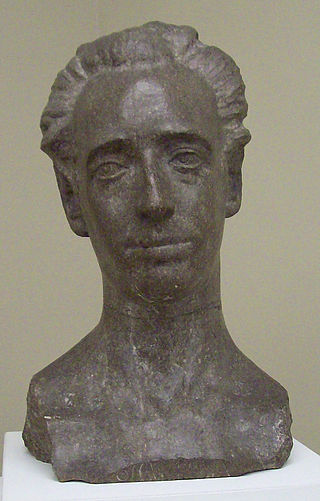
Antonio de Cabezón was a Spanish Renaissance composer and organist. Blind from childhood, he quickly rose to prominence as a performer and was eventually employed by the royal family. He was among the most important composers of his time and the first major Iberian keyboard composer.

Francisco Bartolomé Sanz Celma, better known as Gaspar Sanz, was a Spanish composer, guitarist, and priest born to a wealthy family in Calanda in the comarca of Bajo Aragón, Spain. He studied music, theology and philosophy at the University of Salamanca, where he was later appointed Professor of Music. He wrote three volumes of pedagogical works for the baroque guitar that form an important part of today's classical guitar repertory and have informed modern scholars in the techniques of baroque guitar playing.

Juan del Encina was a composer, poet, priest, and playwright, often credited as the joint-father of Spanish drama, alongside Gil Vicente. His birth name was Juan de Fermoselle. He spelled his name Enzina, but this is not a significant difference; it is two spellings of the same sound, in a time when "correct spelling" as we know it barely existed.
Sebastian Aguilera de Heredia was a Spanish monk, musician and composer.

Antonio Machado Álvarez, better known by his pseudonym Demófilo, was a Spanish writer, anthropologist, and folklorist. He was the son of the noted Spanish folklorist, Cipriana Álvarez Durán.
Julián Ribera y Tarragó was a Spanish Arabist and academic.
Miguel de Fuenllana (c.1500–1579) was a Spanish vihuelist and composer of the Renaissance.

The Cancionero de Palacio, or Cancionero Musical de Palacio (CMP), also known as Cancionero de Barbieri, is a Spanish manuscript of Renaissance music. The works in it were compiled during a time span of around 40 years, from the mid-1470s until the beginning of the 16th century, approximately coinciding with the reign of the Catholic Monarchs.
The ensalada is a genre of polyphonic secular music mixing languages and dialects and nonsensical quodlibets.
The tono humano was one of the main genres of 17th Century Spanish and Portuguese music.
Juan Arañés was a Spanish baroque composer. His tonos and villancicos follow the style of those preserved in the Cancionero of Kraków.
Miguel Ángel Coria Varela was a Spanish composer of classical music. His early work showed affinities to the music of Anton Webern, but he became increasingly influenced by Impressionism. From 1973 he entered his post-modern period where his compositions were marked by "attempts to evoke the spirit of the music of the past, but without literal allusions". In addition to his instrumental music, he also composed an opera, Belisa, which premiered at the Teatro de la Zarzuela in 1992. Coria served as the Administrative Director of the RTVE Symphony Orchestra and Chorus in the 1980s and was a co-founder of ALEA, Spain's first laboratory for electronic music.

Óscar Esplá y Triay was a Spanish composer. The Conservatorio Superior de Música (conservatory) of the city of Alicante is dedicated to him. The Premio internacional de composición Óscar Esplá was created in 1955 and is awarded by the city of Alicante.
The Cancionero de la Colombina or Cancionero Musical de la Colombina (CMC) is a Spanish manuscript containing Renaissance music from the second half of the 15th century.
Pedro de Lagarto was a Spanish singer and composer of the Renaissance period.
The Cancionero de Turin or Cancionero Musical de Turin is a musical manuscript that contains Spanish secular polyphonic works from the period between the end of the 16th century and the beginning of the 17th century, in the transition period between the Renaissance and the Baroque eras.
The Cancionero de Segovia or Cancionero Musical de Segovia (CMS), also known as Cancionero of the Segovia Cathedral, is a manuscript containing Renaissance music from the end of the 15th century and beginning of the 16th century. It contains a wide repertoire of works by mainly Spanish, French and Franco-Flemish composers. It is kept at the Segovia Cathedral Archives.

Adolfo Salazar Ruiz de Palacios was a Spanish music historian, music critic, composer, and diplomat of the first half of the twentieth century. He was the preeminent Spanish musicologist of the Silver Age. Fluent in Spanish, French, and English, he was an intellectual and expert of the artistic and cultural currents of his time, and a brilliant polemicist. He maintained a close connection with other prominent Spanish intellectuals and musicians including José Ortega y Gasset, Jesús Bal y Gay, and Ernesto Halffter. In his writings, he was a defender of the French musical aesthetic of Maurice Ravel and Claude Debussy.
Ángel Manuel Olmos is a Spanish musicologist and entrepreneur. He was music technology and history professor at the University of La Rioja, Honorary Research Fellow at the University of Liverpool and is currently Professor of Musicology at the RCSMM.

María Teresa Oller was a Spanish composer and folklorist of the Valencian Community. Since the 1950s, she carried out extensive fieldwork to collect traditional Valencian music, highlight it, and make it known in numerous publications. Oller was a member of the Real Academia de Bellas Artes de San Carlos de Valencia.








